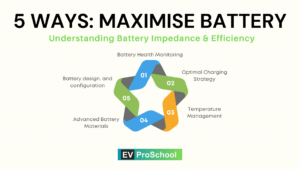We always talk about the efficiency of EV Electric Motors and Controllers. Does Battery also have Efficiency? What does it mean, when I Charge the battery do I lose any Energy? Battery Inefficiency will be whenever whatever is put inside the battery, can I take out all of it?
Here, we dissect the key factors that sway the performance of these power-packed energy reservoirs. State of charge, Charging & Discharging at C-rate of Battery,

Introduction to Battery Parameters
There is an internal resistance associated with the battery. Hence There will be losses when energy goes inside the battery. However, these losses are minimal, typically 1%. Hence from an Efficiency point of view, you don’t need to worry about it. From the heating point of view, you worry about. We will get into more detail as we discuss this topic further.
As you might know, a battery consists of Cells. It is a cells which are put together to make a battery pack. Hence characteristics of cells are going to be characteristics of a battery to a large extent and there may be other additional parameters to a battery.

Charge Current, Time & Voltage
- Charge Current:
- What is it? The rate at which energy flows into the battery during charging.
- Impact: Higher currents generate more heat and can reduce the battery’s life.
- Charge Time:
- Critical Insight: Fast charging may be convenient, but it can also contribute to quicker degradation.
- Why? Rapid charging can cause increased heat, impacting the battery’s chemistry.
- Charge Voltage:
- Voltage Wisdom: Charging beyond recommended voltage can result in stress and compromise safety.
- Balancing Act: Optimal voltage ensures efficient charging without harming the battery.
- Total Charge Rate:
- Holistic Approach: The combination of current, time, and voltage determines the total charge rate.
- Cautious Note: Excessive rates can accelerate wear and tear.
Operating Conditions like Temperature
- Temperature Impact:
- Heat vs. Cold: Extreme temperatures, both hot and cold, can affect battery performance.
- Why? High temperatures accelerate chemical reactions, while cold temperatures increase internal resistance.
- Optimal Range:
- Ideal Conditions: Aim for a temperature range where the battery operates most efficiently.
- Management: Thermal management systems help regulate temperature for optimal performance
Discharge Rate, Current, and Time
- Discharge Rate:
- Decoding Speed: Rapid discharging generates higher currents, impacting the battery’s health.
- Suggestion: Balance the need for speed with the desire for a prolonged battery life.
- Discharge Current:
- Current Matters: The flow of energy during discharge influences the battery’s longevity.
- Lesson Learned: Higher currents can heat up the battery, potentially reducing efficiency.
- End Voltage:
- Voltage Limit: Discharging below recommended levels can damage the battery.
- Cautious Operation: Adhering to end voltage limits safeguards the battery’s well-being.
- Discharge Time:
- Time Wisdom: Prolonged discharging periods can strain the battery.
- Takeaway: Balance discharge times for optimum efficiency.
Battery Cycle Life
- Understanding the Dynamics:
- The frequency at which you charge and discharge your battery impacts its lifespan.
- Why? Every charge-discharge cycle induces a certain level of stress on the battery.
- Optimal Strategy:
- Aim for a balance. Frequent shallow cycles might be less detrimental than infrequent deep cycles.
In Conclusion: Unlocking the Full Potential
Efficiency in electric vehicle batteries is a delicate dance of various factors. Balancing the frequency of charge-discharge cycles, understanding the nuances of charging parameters, and maintaining optimal operating conditions are the keys to unlocking the full potential of these energy reservoirs. So, the next time you plug in your electric vehicle, consider these factors as you embark on a journey towards sustainable and efficient mobility.
Strategy for the Blog Post: “Secrets Factors Influencing Battery Efficiency in Electric Vehicles”
This blog post will explore the key factors affecting EV battery efficiency, explaining how temperature, voltage, capacity loss, and cycling behavior impact performance. The goal is to uncover the “secrets” behind these factors, educate readers on how they influence EV battery life and efficiency, and provide actionable tips to optimize battery usage.
1. Define the Blog’s Objectives
Purpose:
- To explain what influences battery performance and efficiency in electric vehicles.
- To provide practical advice for EV owners to mitigate the effects of these factors.
Target Audience:
- EV owners and potential buyers looking to optimize battery performance.
- EV enthusiasts and sustainability advocates curious about battery technology.
SEO Focus Keyword:
“Battery efficiency in electric vehicles”
Supporting Keywords:
- Factors affecting battery performance
- EV battery temperature
- Battery cycling behavior
- Voltage impact on EV batteries
- Capacity loss in batteries
2. Blog Outline
Title Options:
- Main Title: Secrets Factors Influencing Battery Efficiency in Electric Vehicles
- SEO-Friendly Title: What Affects EV Battery Efficiency? Temperature, Voltage, and More Unveiled
Introduction: Unlocking the Secrets of EV Battery Efficiency
- Hook the reader:
“Ever wondered why some EVs deliver better range and performance than others? The secret lies in understanding what truly influences battery efficiency.” - Explain the importance of efficiency in EV batteries:
- Longer driving range.
- Lower energy costs.
- Reduced environmental impact.
- Preview the blog: “In this post, we’ll uncover how temperature, voltage, capacity loss, and cycling behavior affect your EV’s battery performance.”
Section 1: How Temperature Impacts Battery Efficiency
- Why It Matters:
- Batteries are highly sensitive to extreme temperatures, affecting their ability to store and release energy.
- Key Insights:
- High Temperatures:
- Can accelerate chemical reactions, causing faster degradation.
- Results in capacity loss over time.
- Low Temperatures:
- Reduces battery performance temporarily (slower chemical reactions).
- Increases charging time.
- High Temperatures:
- Real-World Example:
- Tesla’s thermal management systems preheat batteries in cold climates to ensure efficient charging.
- Tips for EV Owners:
- Park in shaded areas or garages during extreme heat.
- Precondition the battery in cold weather before charging or driving.
Section 2: Voltage and Its Role in Battery Efficiency
- What Is Voltage in Batteries?
- Voltage is the potential energy difference that powers the EV.
- Key Insights:
- Overvoltage (charging to 100% frequently):
- Causes stress on battery cells, leading to capacity loss.
- Undervoltage (letting the battery drop below 20%):
- Increases internal resistance and reduces efficiency.
- Overvoltage (charging to 100% frequently):
- Tips for EV Owners:
- Keep the battery between 20%–80% for daily usage.
- Use fast charging sparingly to avoid voltage spikes.
Section 3: Capacity Loss Over Time
- What Is Capacity Loss?
- The gradual reduction in a battery’s ability to hold a charge over its lifespan.
- Key Causes of Capacity Loss:
- Temperature Extremes (discussed earlier).
- Overcharging/Deep Discharging:
- Accelerates chemical wear inside the battery.
- Calendar Aging:
- Even when unused, batteries lose capacity over time due to chemical reactions.
- Visual Idea: Graph showing how capacity diminishes over time based on usage and charging habits.
- Tips for EV Owners:
- Avoid fully charging or fully discharging your battery frequently.
- Store your EV with a charge level of ~50% if unused for extended periods.
Section 4: Cycling Behavior: The Hidden Efficiency Factor
- What Is Battery Cycling?
- A charge cycle is one complete charge and discharge cycle (e.g., from 0% to 100% and back to 0%).
- Key Insights:
- Frequent Full Cycles:
- Increases wear and reduces lifespan.
- Partial Cycles:
- Less stressful on the battery and extends its life.
- Frequent Full Cycles:
- Real-World Analogy:
- “Think of your EV battery like a rubber band. Stretching it fully (full cycle) too often makes it lose elasticity, but stretching it partially keeps it flexible for longer.”
- Tips for EV Owners:
- Use partial charging (e.g., from 20%–80%) for daily driving.
- Plan full charges only for long trips.
Section 5: Putting It All Together: Practical Tips for Better Battery Efficiency
- Summarize Key Actions:
- Monitor and manage temperature conditions.
- Charge wisely to maintain optimal voltage.
- Avoid practices that accelerate capacity loss.
- Optimize cycling behavior with partial charges.
- Benefits of Following These Practices:
- Longer battery life.
- Improved EV range and performance.
- Cost savings by delaying battery replacements.
- Expert Quote/Stat:
- “Studies show that maintaining optimal temperature and charging habits can extend EV battery life by up to 30%.”
Conclusion: Understanding Leads to Efficiency
- Reinforce the idea that knowing how temperature, voltage, capacity loss, and cycling behavior impact battery performance is key to maximizing efficiency.
- Encourage readers to adopt the practical tips shared in the blog.
- End with a call-to-action:
“Want to dive deeper into EV battery optimization? Check out our guide to smart charging habits and thermal management!”
3. Writing Style and Tone
- Tone: Informative but engaging, suitable for both casual EV users and tech-savvy readers.
- Use relatable analogies to simplify complex topics:
- “Think of battery voltage like water pressure in a hose—too much pressure (overvoltage) strains the system, while too little (undervoltage) doesn’t get the job done.”
4. Suggested Visuals and Graphics
- Infographic: Key factors affecting battery efficiency (temperature, voltage, capacity loss, cycling behavior).
- Graph: Battery capacity loss over time with proper vs improper habits.
- Diagram: Effects of temperature extremes on battery performance.
- Real-World Example: Image of Tesla’s thermal management system in action.
5. SEO Optimization Strategy
Focus Keyword:
“Battery efficiency in electric vehicles”
Supporting Keywords:
- Factors affecting battery performance
- Temperature and EV batteries
- Voltage and battery efficiency
- Capacity loss in EV batteries
Meta Description:
“Unlock the secrets to EV battery efficiency! Learn how temperature, voltage, capacity loss, and cycling behavior impact performance and discover tips to optimize your electric vehicle’s battery life.”
Alt Text for Feature Image:
“Infographic showing factors influencing EV battery efficiency, including temperature, voltage, and cycling behavior.”
6. Blog Length
- Target Word Count: 1,600–2,000 words to thoroughly cover technical insights and practical advice.
By following this strategy, the blog will serve as a comprehensive and actionable guide, helping EV owners understand and improve their battery performance while attracting readers with its SEO-optimized content.



